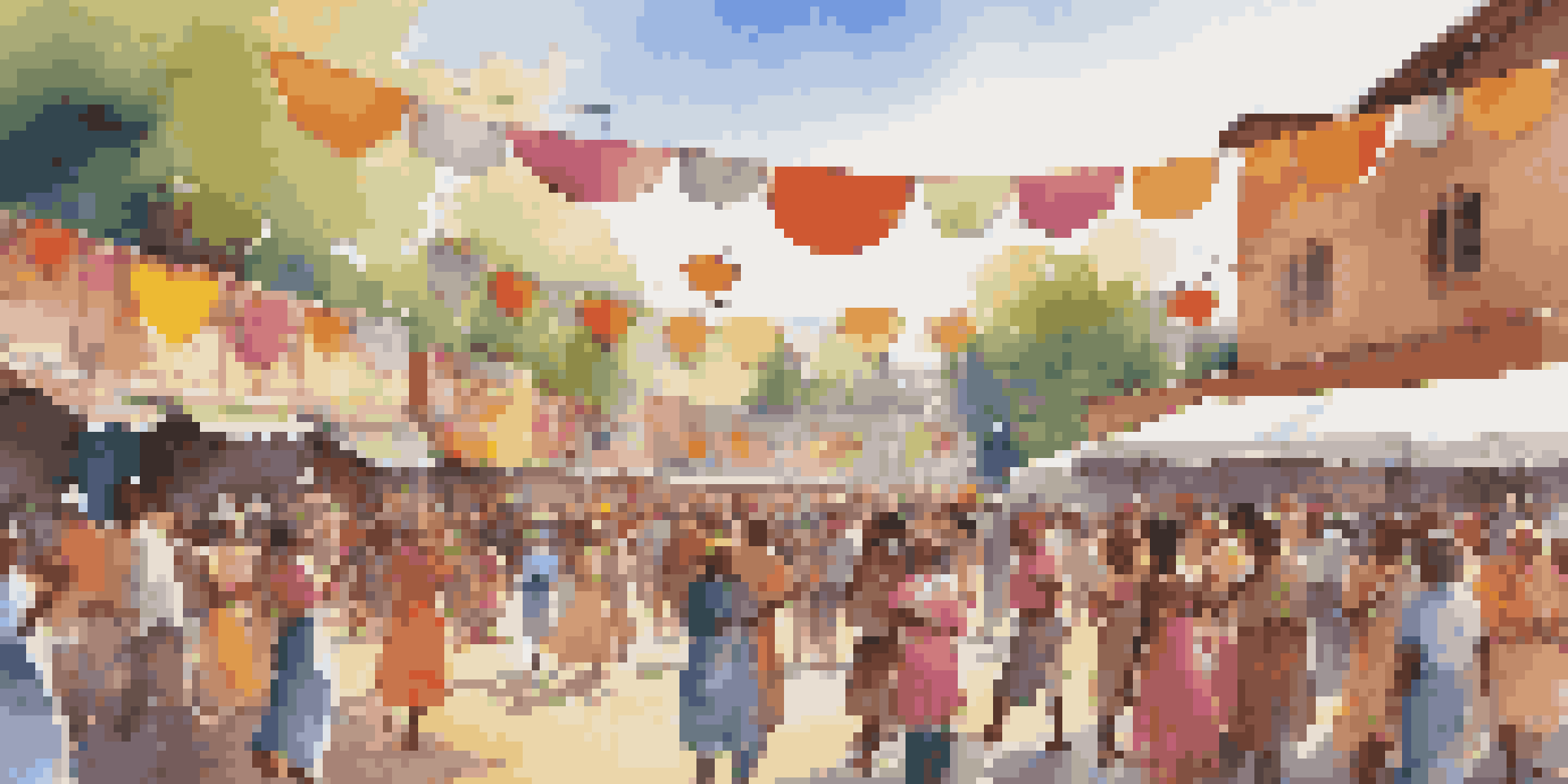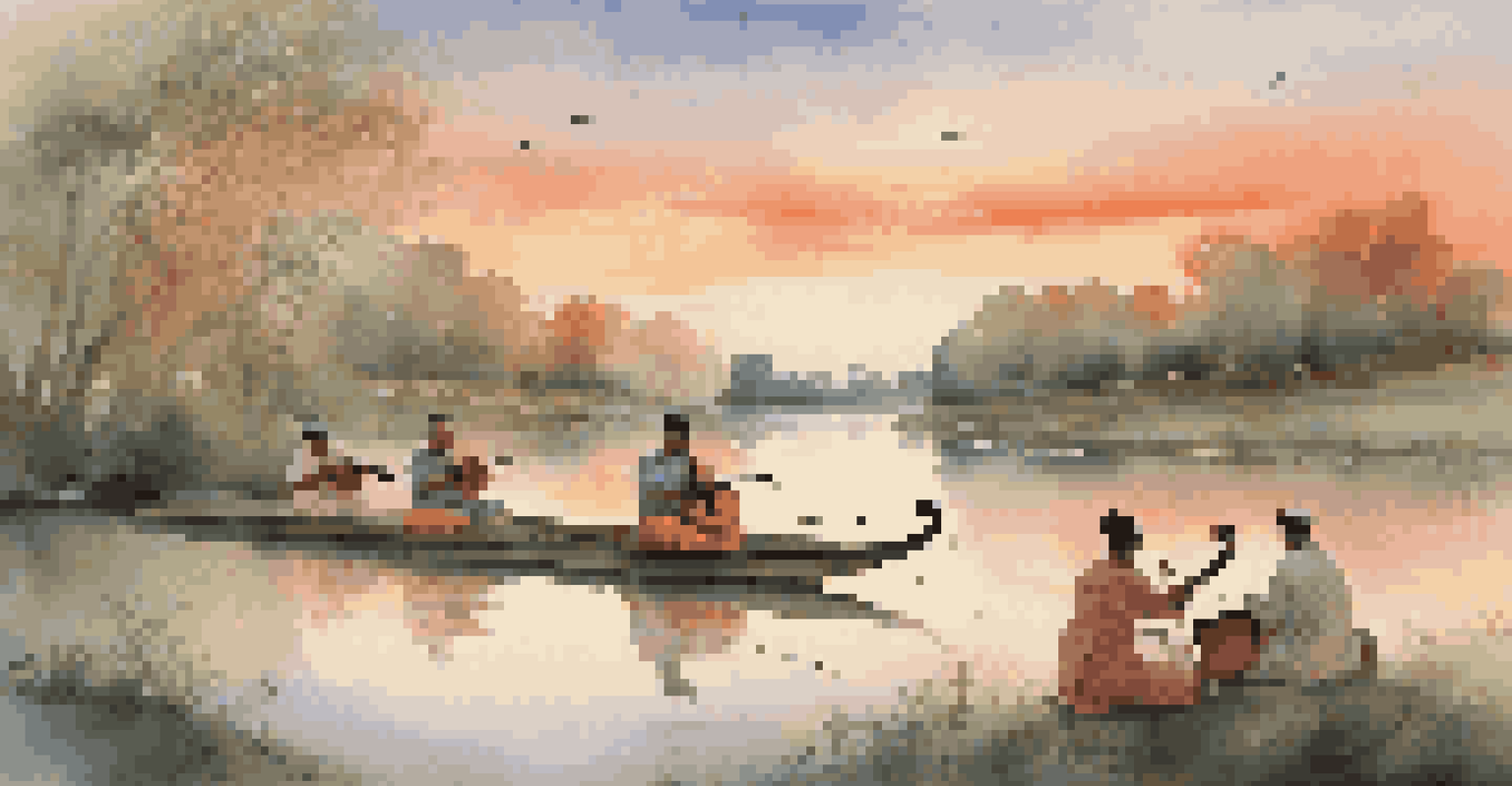Music as a Medium for Storytelling and Community Narratives

The Power of Music in Storytelling
Music has a unique ability to convey emotions and narratives that words alone often cannot express. Think about how a simple melody can evoke memories or feelings, transporting us to different times and places. This emotional resonance makes music an effective storytelling medium, allowing artists to articulate complex experiences in a relatable way.
Music can change the world because it can change people.
From folk ballads recounting historical events to modern hip-hop narrating personal struggles, music serves as a canvas for diverse stories. Each genre brings its own narrative style, influencing how audiences interpret and connect with the message. This multiplicity of perspectives enriches the storytelling landscape, showcasing the depth of human experience.
Moreover, music can engage listeners on a personal level, as it often reflects shared struggles or triumphs within a community. When people hear a song that resonates with their own life story, it creates an immediate bond, fostering a sense of belonging and understanding.
Cultural Narratives Through Musical Genres
Different musical genres often reflect the cultural narratives of their origins. For instance, blues music emerged from the African American experience in the Deep South, telling stories of hardship and resilience. Similarly, reggae music encapsulates the struggles and triumphs of Jamaican culture, promoting messages of peace and social justice.

These genres do more than entertain; they educate listeners about the historical and social contexts from which they arise. By engaging with these musical forms, audiences gain insight into the lives and experiences of others, fostering empathy and understanding. This cultural exchange is vital in a globalized world where diverse narratives can sometimes clash.
Music's Emotional Power
Music can convey complex emotions and narratives, creating deep connections with listeners.
As genres continue to evolve and blend, new stories emerge, reflecting contemporary issues and global interconnectedness. This fusion not only keeps the narratives alive but also allows for innovative expressions of community identity and resilience.
Community Bonds Strengthened Through Shared Music
Music has a remarkable ability to bring people together, creating a sense of community through shared experiences. Whether it's singing along at a concert, participating in a local jam session, or enjoying a festival, these communal activities foster connections among individuals. This shared participation can nurture relationships and build a sense of belonging.
Where words fail, music speaks.
For many communities, music acts as a unifying force, especially during significant events like weddings, funerals, or cultural festivals. These occasions often include traditional songs that carry deep meanings, celebrating heritage and collective memories. In this way, music becomes a vital part of the community’s identity and continuity.
Moreover, the act of creating music together—be it through choirs, bands, or informal gatherings—encourages collaboration and friendship. As individuals contribute their unique voices and perspectives, they weave a rich tapestry of sound that tells their collective story, reinforcing the idea that music is a powerful medium for communal narratives.
The Role of Lyrics in Conveying Messages
Lyrics serve as the backbone of many songs, functioning as the primary vehicle for storytelling. Through carefully chosen words, songwriters can encapsulate complex ideas, emotions, and experiences in a few verses. This lyrical storytelling allows listeners to engage intellectually and emotionally, connecting with the themes presented.
For example, Bob Dylan's protest songs not only entertained but also educated audiences about social issues, sparking conversations and inspiring movements. Similarly, contemporary artists often tackle themes like love, loss, and identity, making the personal universal. This accessibility invites listeners to reflect on their own lives, fostering a deeper connection with the music.
Cultural Reflections in Genres
Different musical genres encapsulate the cultural narratives and experiences of their origins.
Well-crafted lyrics can resonate across generations, becoming anthems for social change or personal empowerment. This timeless quality underscores music's role as a powerful tool for storytelling that transcends cultural and temporal boundaries.
Music as a Historical Document
Music can also serve as a historical document, capturing the essence of a particular time and place. The songs created during significant historical events often reflect the sentiments of those who lived through them. For instance, the music of the Civil Rights Movement is not just entertaining; it encapsulates the struggles, hopes, and dreams of those who fought for justice.
These musical artifacts provide insights into societal attitudes, cultural shifts, and collective memories. By examining the lyrics and themes of songs from different eras, we can better understand the challenges and triumphs faced by communities. This historical perspective enriches our appreciation of music as more than just entertainment—it becomes a vital record of human experience.
Furthermore, as we listen to these songs, we connect with the past, reminding us that music has always played a crucial role in shaping narratives and preserving history. This connection can inspire contemporary movements, encouraging new generations to continue the fight for social justice and equality.
The Impact of Technology on Musical Storytelling
In recent years, technology has transformed the way music is created, shared, and consumed, impacting storytelling in profound ways. With the rise of digital platforms, artists can reach global audiences, sharing their narratives with people from diverse backgrounds. This accessibility has democratized music, allowing more voices to be heard and stories to be told.
Moreover, technology facilitates innovative storytelling techniques, such as multimedia projects that combine music with visual art and interactive elements. This fusion enhances the narrative experience, engaging audiences on multiple levels. As listeners interact with music through videos, social media, and virtual concerts, they become part of the storytelling process.
Community Through Shared Music
Music fosters a sense of community and belonging, strengthening bonds through shared experiences.
However, this shift also poses challenges, as the sheer volume of content can sometimes dilute individual stories. It’s essential for artists to find ways to stand out and convey their unique narratives amidst the noise. Balancing innovation with authenticity remains key in ensuring that music continues to serve as a meaningful medium for storytelling.
Conclusion: The Enduring Legacy of Music as Storytelling
As we explore the multifaceted relationship between music and storytelling, it becomes clear that music is more than just sound; it’s a vital part of human expression and connection. Through its ability to convey emotions, reflect cultural narratives, and foster community bonds, music remains an enduring medium for storytelling. Whether through lyrics, melodies, or rhythms, the stories told through music resonate deeply with audiences.
In a rapidly changing world, these narratives remind us of our shared humanity and the power of connection. As we listen to and create music, we continue to weave the threads of our stories, preserving the past while shaping the future. The legacy of music as a storytelling medium will undoubtedly endure, inspiring generations to come.

Ultimately, embracing the stories that music tells allows us to appreciate the diverse tapestry of human experience. By engaging with these narratives, we honor the voices of those who came before us and pave the way for new stories to emerge, ensuring that music remains a vital part of our collective journey.